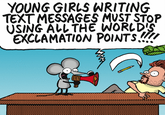The Law of Exclamation
Confirmed 71,168

| Navigation |
| About • Origin • Spread • Related Memes • Search Interest • External References • Recent Images |
About
The Law of Exclamation is an Internet axiom arguing that a statement’s validity is called into question by the amount of exclamation points used. While the statement was originally made in reference to chain emails and message board postings, it can be also applied to any text found online.
Origin
The use of multiple exclamation points being associated with email hoaxes was noted as early as 1997 in two separate articles published by the IBM research team. The first[19] was uploaded that January and intended as a guide for lay population to be able to identify an email virus hoax. The second was a scientific research paper titled “Hoaxes and Hypes”[18] presented later that year at the 7th Virus Bulletin International Conference held in San Francisco, California.
Precursor
Throughout his fantasy novel series Discworld[2], Terry Pratchett uses exclamation points in characters’ dialogue as a method of describing their sanity.[3] In the 11th installment of the series titled Reaper Man[4], a character is quoted as saying "Five exclamation marks, the sure sign of an insane mind." In 2007, the book Send[6] tried to implement a new set of style guidelines for email etiquette that encouraged the use of exclamation marks as a way to show appreciation and excitement in text-only situations.
This was debated in a Slate[5] article, which cited esteemed author Elmore Leonard's suggestion of using no more than two to three exclamation points per 100,000 words of prose from a 2001 New York Times[7] article. However, neither of these suggest usage of exclamation points to be indicative of the statement's validity.
Spread
The observation gained significant credibility in March 2008 after FactCheck.org, a nonpartisan voter education project by the University of Pennsylvania’s Annenberg Public Policy Center, published an article[1] about the validity of chain emails relating to democratic politicians Barack Obama, Hillary Clinton and Bill Clinton. After finding only 2 of the 31 emails they analyzed contained factual information, author Lori Robertson offered seven tips to look for when reading a suspicious e-mail. One of them addressed the overuse of exclamation points:
The author just loves using exclamation points. If the author had a truthful point to make, he or she wouldn’t need to put two, three, even five exclamation points after every other sentence. In fact, we're developing another theory here: The more exclamation points used in an e-mail, the less true it actually is. (Ditto for excessive use of capital letters.)
The Law of Exclamation was submitted to Rational Wiki[8] in September 2008. The adage was highlighted in another article by The Telegraph[9] in October 2009 and subsequently picked up by the Democratic Underground forums[10] as well as personal blogs including Michael Savoie.com[11], Blurred Clarity[12] and Open Parachute.[13] Additionally, the law has also been applied to fake Facebook[20] profiles and hotel reviews.[21]
The overuse of exclamation points in email has also been discussed on the Guardian[14], GOOD[15], the Boston Globe[16] and PR Daily[17], but none of these stories implicate the amount of punctuation in a sentence with the likelihood of it being a hoax.
Related Memes
The "!1" Phenomenon
The “!1” Phenomenon is a well-known but sparsely documented typo that is commonly found in online conversations. In many cases, a string of exclamation marks followed by “1” can be read as a careless typo, though it has been increasingly used with intention to express a sense of urgency or excitement. It is considered part of leetspeak, an alternative alphabet for the English-speaking internet users.
Search Interest
[not available]
External References
[1] FactCheck.org – That Chain E-mail Your Friend Sent to You Is (Likely) Bogus. Seriously.
[3] Terry Pratchett Wiki – Multiple exclamation marks
[4] Terry Pratchett Wiki – Reaper Man
[5] Slate – So Many Exclamation Points!
[7] New York Times – Elmore Leonard’s Ten Rules of Writing: Easy on the Adverbs, Exclamation Points and Especially Hooptedoodle
[8] Rational Wiki – Law of Exclamation
[9] Telegraph – Internet rules and laws: the top 10, from Godwin to Poe
[10] Democratic Underground – Internet rules and laws: the top 10, from Godwin to Poe
[11] Michael Savoie – The Need for Alternative Punctuation
[12] Blurred Clarity – Internet Laws Part 1: The Law of Exclamation
[13] Open Parachute – Judging the internet – and books
[14] The Guardian – The joy of exclamation marks! [2009]
[15] GOOD – Enough with the Exclamation Points!!! Four Uses for the Most Overused Punctuation [2010]
[16] Boston Globe – The overuse of exclamation points! [2012]
[17] PR Daily – Are exclamation points overused in our emails? [2012]
[18] IBM – Hoaxes and Hypes | Appendix A
[19] IBM – How to Spot a Virus Hoax
[20] Jon Loomer – 6 Steps to a Good Facebook Hoax
[21] The Atlantic – How to Spot a Fake Online Hotel Review
Share Pin
Recent Images 7 total
Recent Videos 0 total
There are no recent videos.






